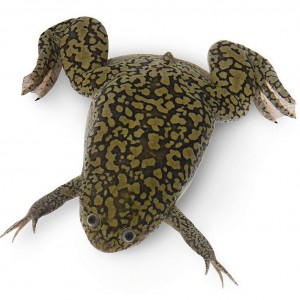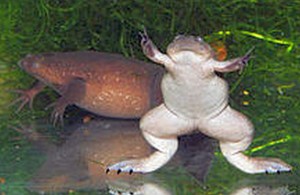The Western Clawed Frog (Xenopus tropicalis) also known to tropical fish keeping enthusiasts as the Tropical Clawed Frog inhabits the tropical and subtropical rain forests of Western Africa from Senegal to Cameroon and eastern Zaire where it inhabits slow moving rivers, streams, swamps, freshwater lakes, marshes, ponds, canals, and ditches throughout their range.
They have a wide range and are found throughout Cameroon, the Ivory Coast, Burkina Faso, Benin, Equatorial Guinea, Gambia, Ghana, Guinea, Guinea Bissau, Liberia, Nigeria, Senegal, Sierra Leone, Togo, and possibly even Mali.
Because it is the only species in the Xenopus genus that has a diploid (cells with two homologous copies of each chromosome; normally one from the mother and one from the father) genome which has been sequenced, it along with it’s cousin the African Clawed Frog (Xenopus laevis), is widely bred and used in biological and genetic research. Xenopus tropicalis have a much shorter life cycle than Xenopus laevis, grow to only 1.95″ long, and attain adulthood at only 4 months, vs. 12 months for Xenopus tropicalis.
Xenopus tropicalis is a medium sized species that has a flattened body, bulging eyes that are situated high on their head, short plump limbs, and fully webbed feet with horny like claws. They have a short tentacle below each eye and a row of tubercles that run along a lateral line on their flank that begins at the eye. They have a fine granular skin, a pale to dark brown body with small black and gray spots on the back, and a creamy white to yellowish underbelly with some darker mottling.
Western Clawed Frogs should be housed in an aquarium of at least 10 gallons with a medium size gravel substrate, some hardy aquatic plants along with some driftwood and rock work structure for them to hide among, and some floating plants
to diffuse the lighting in the tank.
They require adequate filtration, but avoid any strong currents in the tank. These frogs need a tightly fitting cover to prevent them from crawling out of their tanks. They are best kept in a single species tank with 4 or 5 others of their own kind, but they can be kept in a community environment as long as the fish are not smaller than themselves.
In the wild, Western Clawed Frogs are found underneath flat stones, tree roots, and holes in the riverbanks of shallow streams during the dry season, and when the rainy season begins, they migrate across the wet rain forest floor at night to find small pools where they can spawn. Their spawning behavior is like that of the African Clawed Frog (Xenopus laevis) but they produce a larger number of eggs per spawn and have a shorter (5 month) generation time. The usually lay their eggs on plants, but they are often found floating on the water surface.
The tadpoles are generally an orange color with transparent to blackish colored tails. They have wide mouths that are used to filter zooplankton from the water, and they transform into adults when they reach about 2 inches in length.
In their natural habitat, adult Western Clawed Frogs feed on insect larvae, small fish, tadpoles, and earthworms. In an aquarium environment, they should be feed meaty foods like live, frozen, or freeze dried bloodworms, waxworms, earthworms
, tubifex, feeder fish, guppies, brine shrimp, or sinking carnivore pellets. They will also eat fish smaller than themselves. Feed them either every couple of days, or smaller portions daily.
Western Clawed Frogs are available online or from specialty tropical fish keeping shops at reasonable prices when they are about 1 1/2″ in size.
Minimum Tank Size: 10 gallons
Care Level: Easy
Temperament:
Aquarium Hardiness: Hardy
Water Conditions: 72-82° F, KH 5-8, pH 6.8-7.8
Max Size: 1 1/2” to 2 1/4”
Color Form: Brown, Tan
Diet: Omnivore
Compatibility: Single species or Community
Origin: Senegal, Cameroon, Zaire
Family: Pipidae
Life Span: 5-20 years
Aquarist Experience Level: Beginner



